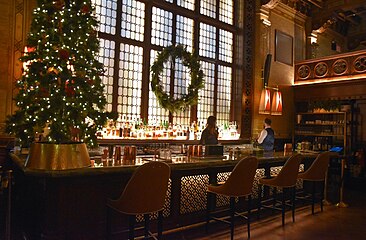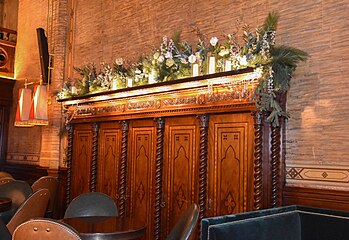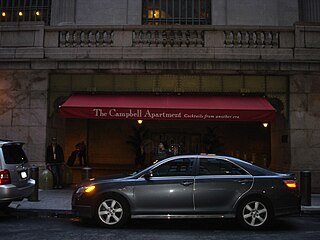
Grand Central Terminal is a commuter rail terminal located at 42nd Street and Park Avenue in Midtown Manhattan, New York City. Grand Central is the southern terminus of the Metro-North Railroad's Harlem, Hudson and New Haven Lines, serving the northern parts of the New York metropolitan area. It also contains a connection to the Long Island Rail Road through the Grand Central Madison station, a 16-acre (65,000 m2) rail terminal underneath the Metro-North station, built from 2007 to 2023. The terminal also connects to the New York City Subway at Grand Central–42nd Street station. The terminal is the third-busiest train station in North America, after New York Penn Station and Toronto Union Station.

A penthouse is an apartment or unit on the highest floor of an apartment building, condominium, hotel, or tower. Penthouses are typically differentiated from other apartments by luxury features. The term 'penthouse' originally referred, and sometimes still does refer, to a separate smaller 'house' that was constructed on the roof of an apartment building. Architecturally it refers specifically to a structure on the roof of a building that is set back from its outer walls. These structures do not have to occupy the entire roof deck. Recently, luxury high rise apartment buildings have begun to designate multiple units on the entire top residential floor or multiple higher residential floors including the top floor as penthouse apartments, and outfit them to include ultra-luxury fixtures, finishes, and designs which are different from all other residential floors of the building. These penthouse apartments are not typically set back from the building’s outer walls, but are instead flush with the rest of the building and simply differ in size, luxury, and consequently price. High-rise buildings can also have structures known as mechanical penthouses that enclose machinery or equipment such as the drum mechanisms for an elevator.
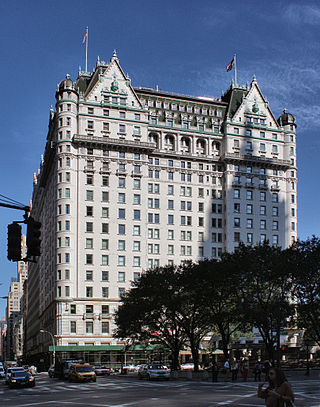
The Plaza Hotel is a luxury hotel and condominium apartment building in Midtown Manhattan in New York City. It is located on the western side of Grand Army Plaza, after which it is named, just west of Fifth Avenue, and is between 58th Street and Central Park South, at the southeastern corner of Central Park. Its primary address is 768 Fifth Avenue, though the residential entrance is One Central Park South. Since 2018, the hotel has been owned by the Qatari firm Katara Hospitality.

The New York Biltmore Hotel was a luxury hotel at 335 Madison Avenue in Midtown Manhattan, New York City. The hotel was developed by the New York Central Railroad and the New York, New Haven and Hartford Railroad and operated from 1913 to 1981. It was one of several large hotels developed around Grand Central Terminal as part of Terminal City. The Biltmore was designed in the Italian Renaissance Revival style by Warren and Wetmore, one of the firms involved in designing Grand Central. Although the hotel's steel frame still exists, the hotel itself was almost entirely demolished and replaced by an office building in the early 1980s.
John Williams Campbell (1880–1957) was a millionaire American financier and railroad executive. He kept an office at Grand Central Terminal in New York City, which was later converted into a bar called the Campbell Apartment, a popular gathering spot for commuters and others after work.
Augustus N. Allen was an architect known for designing buildings on Long Island and in New York City, as well as New Jersey. He also designed the office of American financier and railroad executive John W. Campbell at Grand Central Terminal, which was later converted into a bar called the Campbell Apartment.
The Prudence Building, or Prudence Bonds Building, was a fourteen-story edifice at the southeast corner of Madison Avenue and 43rd Street, in Midtown Manhattan, New York City. It was the headquarters of the Prudence Bonds Corporation, opening in October 1923. Stores on the street level were leased to affluent shops. The banking floor was a close likeness of the Bankers Trust Company building at the southeast corner of Fifth Avenue and 42nd Street. The Bank of Manhattan was accorded a 21-year lease and moved its headquarters from 40 Wall Street. The building was demolished in 2016 and the site is now the location of One Vanderbilt.

The Wilbraham is an apartment building at 282–284 Fifth Avenue and 1 West 30th Street in the Midtown South neighborhood of Manhattan in New York City. The nine-story structure was designed by David and John Jardine in the Romanesque Revival style, with elements of the Renaissance Revival style, and occupies the northwestern corner of 30th Street and Fifth Avenue. It was built between 1888 and 1890 as a bachelor apartment hotel. The Wilbraham is a New York City designated landmark and is listed on the National Register of Historic Places.

The Dorilton is a luxury residential housing cooperative at 171 West 71st Street, at the northeast corner with Broadway, on the Upper West Side of Manhattan in New York City. The 12-story building, designed by local firm Janes & Leo in the Beaux-Arts style, was built between 1900 and 1902 for real estate developer Hamilton M. Weed. The Dorilton is a New York City designated landmark and is listed on the National Register of Historic Places.

1049 Fifth Avenue is a 23-floor luxury condominium apartment building located in the Upper East Side, New York City. Built in 1928 as the Adams Hotel, the building underwent extensive renovation in its conversion to residential condominiums during the years 1990-1993. When the apartments were first offered for sale in 1991, they were the highest-priced residential apartments ever listed in New York City. Their sale prices set city records in 1993 and 1994.

The InterContinental New York Barclay Hotel is a hotel at 111 East 48th Street, on Lexington Avenue between 48th and 49th Streets, in the Midtown Manhattan neighborhood of New York City. The 14-story hotel, operated by IHG Hotels & Resorts, was designed by Cross and Cross in the Colonial style and contains 702 rooms. The Barclay was one of several large hotels developed around Grand Central Terminal as part of Terminal City.

Sleepy Hollow Country Club is a historic country club in Scarborough-on-Hudson in Briarcliff Manor, New York. The club was founded in 1911, and its clubhouse was known as Woodlea, a 140-room Vanderbilt mansion owned by Colonel Elliott Fitch Shepard and his wife Margaret Louisa Vanderbilt Shepard. It was built in 1892–95 at a cost of $2 million and was designed by the architectural firm McKim, Mead & White; the estate became a contributing property to the Scarborough Historic District in 1984.

One Vanderbilt is a 73-story supertall skyscraper at the corner of 42nd Street and Vanderbilt Avenue in the Midtown Manhattan neighborhood of New York City. Designed by Kohn Pedersen Fox for developer SL Green Realty, the skyscraper opened in 2020. Its roof is 1,301 feet (397 m) high and its spire is 1,401 feet (427 m) above ground, making it the city's fourth-tallest building after One World Trade Center, Central Park Tower, and 111 West 57th Street.

The Gainsborough Studios, also known as 222 Central Park South, is a residential building on Central Park South, just east of Columbus Circle, in Midtown Manhattan, New York City. Designed by Charles W. Buckham, the building is 16 stories tall with 34 apartments. Named after English painter Thomas Gainsborough, the building is one of several in Manhattan that were built in the early 20th century as both studios and residences for artists.
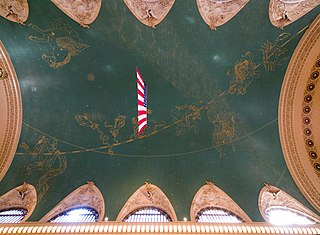
Grand Central Terminal, one of the main railroad stations in New York City, features public art by a variety of artists. Through its status as a transportation and architectural icon, the terminal has also been depicted in many works of art.

Grand Central Terminal is a major commuter rail terminal in Midtown Manhattan, New York City, serving the Metro-North Railroad's Harlem, Hudson and New Haven Lines. It is the most recent of three functionally similar buildings on the same site. The current structure was built by and named for the New York Central Railroad, though it also served New York Central's successors as well as the New York, New Haven and Hartford Railroad.
5 Columbus Circle is an office building on the southeast corner of Broadway and 58th Street, just south of Columbus Circle, in the Midtown Manhattan neighborhood of New York City, New York, United States. Designed by Carrère and Hastings in the Beaux-Arts style, it is 286 feet (87 m) tall with 20 stories.

The Main Concourse is the primary concourse of Grand Central Terminal, a railway station in Midtown Manhattan, New York City. The space is located at the center of the terminal's station building.
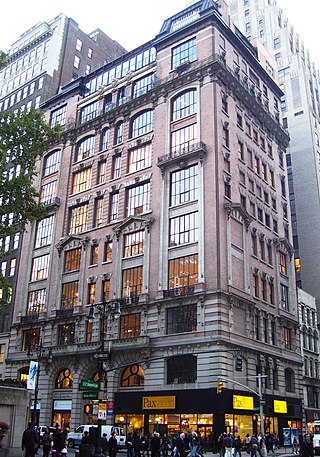
The Bryant Park Studios is an office building at 80 West 40th Street in the Midtown Manhattan neighborhood of New York City, at the corner of 40th Street and Sixth Avenue. The building, overlooking the southwest corner of Bryant Park, was designed by Charles A. Rich in the French Beaux-Arts style. Built from 1900 to 1901 by Abraham A. Anderson, the building is one of several in Manhattan that were built in the early 20th century as both studios and residences for artists.

4 Park Avenue is a 22-story building in the Murray Hill neighborhood of Manhattan in New York City. Designed by Warren and Wetmore, the structure was built for Alfred Gwynne Vanderbilt and opened in 1912 as a hotel. It is along the west side of Park Avenue between 33rd and 34th Streets. Following a renovation by Schuman, Lichtenstein & Claman between 1965 and 1967, the top 18 stories have been used as residential apartments. The lowest three stories above ground, as well as three basement levels, are used as commercial space and carry an alternate address of 6 Park Avenue. As of 2021, the building is owned by The Feil Organization.


